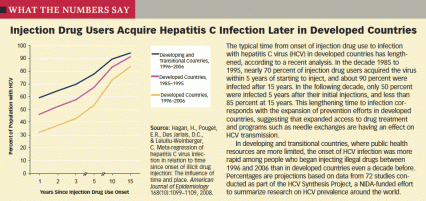 The typical time from onset of injection drug use to infection with hepatitis C virus (HCV) in developed countries has lengthened, according to a recent analysis. In the decade 1985 to 1995, nearly 70 percent of injection drug users acquired the virus within 5 years of starting to inject, and about 90 percent were infected after 15 years. In the following decade, only 50 percent were infected 5 years after their initial injections, and less than 85 percent at 15 years. This lengthening time to infection corresponds with the expansion of prevention efforts in developed countries, suggesting that expanded access to drug treatment and programs such as needle exchanges are having an effect on HCV transmission. In developing and transitional countries, where public health resources are more limited, the onset of HCV infection was more rapid among people who began injecting illegal drugs between 1996 and 2006 than in developed countries even a decade before. Percentages are projections based on data from 72 studies conducted as part of the HCV Synthesis Project, a NIDA-funded effort to summarize research on HCV prevalence around the world.
The typical time from onset of injection drug use to infection with hepatitis C virus (HCV) in developed countries has lengthened, according to a recent analysis. In the decade 1985 to 1995, nearly 70 percent of injection drug users acquired the virus within 5 years of starting to inject, and about 90 percent were infected after 15 years. In the following decade, only 50 percent were infected 5 years after their initial injections, and less than 85 percent at 15 years. This lengthening time to infection corresponds with the expansion of prevention efforts in developed countries, suggesting that expanded access to drug treatment and programs such as needle exchanges are having an effect on HCV transmission. In developing and transitional countries, where public health resources are more limited, the onset of HCV infection was more rapid among people who began injecting illegal drugs between 1996 and 2006 than in developed countries even a decade before. Percentages are projections based on data from 72 studies conducted as part of the HCV Synthesis Project, a NIDA-funded effort to summarize research on HCV prevalence around the world.Source
Hagan, H., Pouget, E.R., Des Jarlais, D.C., & Lelutiu-Weinberger, C. Meta-regression of hepatitis C virus infection in relation to time since onset of illicit drug injection: The influence of time and place. American Journal of Epidemiology 168(10):1099-1109, 2008. [Full Text (PDF, 155KB)]
